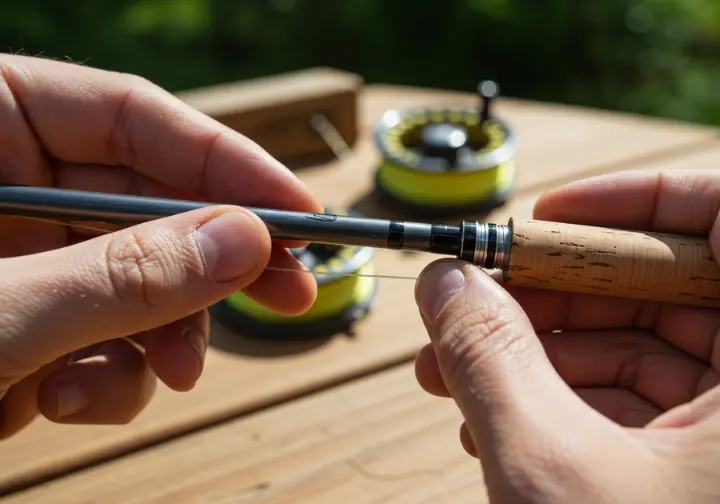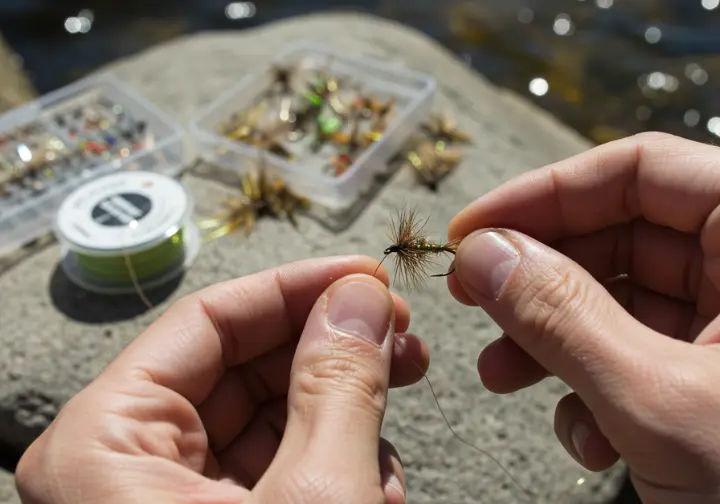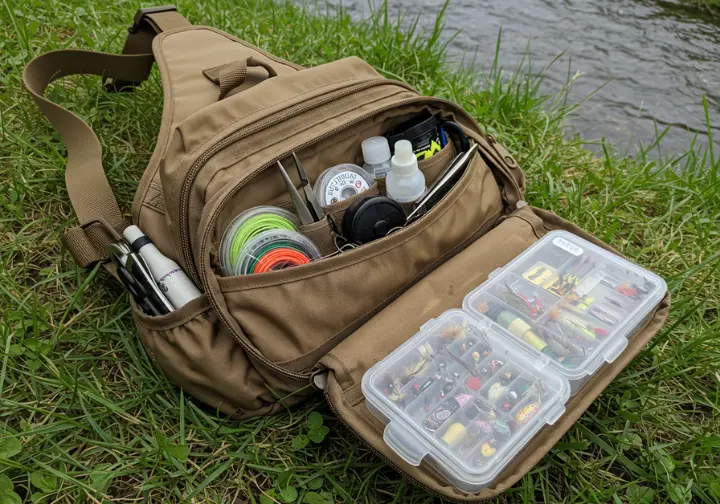In this article
Ready to hit the water? You’ll need a 9-foot, 5-weight rod combo from your fly fishing gear list—it’s versatile and forgiving for beginners. Match your fly line weight to your rod, and grab a weight-forward floating line to make casting easier. Stock up on 4X-6X tippet spools, nippers, and forceps as your essentials. Layer breathable waders with moisture-wicking clothes, and don’t skip polarized sunglasses—they’re a game changer. A fly fishing vest keeps all your gear accessible while you’re on the move. Skip the specialized equipment for now; focus on practicing casting and knots instead. Swing by a local fly shop for expert tips, and dive into more details there.
Understanding Core Gear Basics

You’ll need to grasp the ABCs of fly fishing gear to get started. We’re going to look at selecting your fly rod, choosing the right reel, and grasping fly line necessities. Let’s get into it, so you’re ready for your next cast! A 9-foot, 5-weight rod is versatile for beginners and ideal for learning the fundamentals.
Selecting Your Fly Rod
Your fly rod is the most important tool, crucial for casting and catching fish. Finding the perfect fly rod for beginner fly fishing starts with comprehending a few key things. A 5-weight fishing rod is your best bet for versatility. You’ll find it’s great for trout and most freshwater species.
When picking fly rods, consider the action. Medium or medium-fast action fishing rods are more forgiving, making it easier for you to learn. Look for a 9-foot fly rod; it’s an ideal all-around length. The rod’s weight indicates its force. This 5-weight fly rods hits a sweet spot. Buying a fly fishing outfit simplifies things; these usually include a matching fishing rod and line, giving you the best bang for your buck.
Choosing the Right Reel
Since the reel is more than just a line holder, selecting the right one is a critical step in assembling a balanced fly fishing setup. You’ve gotta start by matching the fly reel weight to your beginner fly rod; a balanced rod and reel combo improves casting and reduces fatigue. A reliable drag system in your fly fishing equipment is paramount; even for trout fishing, smooth drag prevents tippet breakage.
Consider reels with a large arbor design. These reels retrieve line faster. Entry-level reels are often very affordable. You don’t need expensive rods and reels. For fly fishing gear, look for dependable reels with smooth drag. Guarantee the fly fishing reel balances well with your fly fishing rod.
Understanding Fly Line Essentials
If the fly reel serves as the muscle for line retrieval and smooth drag, then the fly line is the very lifeblood of your fly fishing setup. For beginner fly fishing, you’ll want a weight-forward (WF) floating line. The WF taper helps you load the rod easily. Too, bear in mind the fly line weight must match your rod’s weight. Grab a wf taper floating line.
It’s versatile fly tackle for presenting dry flies or indicator nymphing. Don’t go for the cheapest fishing line, but beginner fly lines from Rio or Scientific Anglers work great. A brighter colored fishing line aids in tracking your cast. We all know visibility helps. Fly fishing boils down to matching your gear; the fly line is vital for a beginner fly angler.
Matching the hatch is key when selecting fly patterns to pair with your line setup.
Choosing Your First Setup

You’re ready to buy your first fly fishing setup, and I know you’re hyped! We’ll look at why combos are usually the best bet for starting out, then check out some stellar beginner combos for 2025, plus I’ll give you some rod picks if you want to go a la carte.
The Combo Advantage (Budget Friendly)
For beginners aiming to start fly fishing without emptying their wallets, a fly fishing combo can be a transformation. You’re not stuck guessing which fly fishing rod, fly fish, and rod and reel match. A combo simplifies your fly fishing gear list. You get balanced fly fishing equipment designed fly fishing for beginners. Forget analysis paralysis!
Choosing a budget-friendly combo is cost-effective. Fly fisherman get all their necessary fishing equipment and fishing gear at once, often with fly fishing accessories included. Manufacturers guarantee the rod, reel, and line work together, easing casting. Many combos come pre-spooled and may include a leader, getting you fishing quickly. The forgiving action of the fly fishing accessories included helps you learn. Combos may even have warranties!
A well-matched combo ensures proper line weight for smooth casting, just as specialized fly rods require.
Top Beginner Combos 2025
Diving into fly fishing need not be intimidating; finding the right fly-fishing gear is easier than you think! We’ve compiled top beginner combos for 2025. Consider the Maxcatch Premier Combo, it’s highly recommended, with fishing accessories and fishing tools.
Orvis Encounter Outfit, is a quality setup including a great warranty. Redington Path Combo will keep you reeling, balance performance and value effectively! TFO NXT Black Label Combo brings quality to an accessible price, prioritize rod feel. Echo Lift Combo provides dependable, easy-casting, and durable fishing gear.
You’ll be set up for success using one of these fly fishing combo options when starting your fly fishing expedition! Regarding first-time fly fisher choices, you can’t go wrong with these beginner combos. Custom flies enhance fishing success by matching unique preferences and local conditions.
Recommended Budget Rods 2025 (If Buying Separately)
If you’re assembling your fly fishing setup piece by piece, selecting the right budget rod can significantly impact your early experiences on the water. As for budget-friendly fly fishing gear, several options stand out for 2025. The Greys Lance offers exceptional value and versatile performance. Orvis Clearwater’s forgiving action is excellent for beginners.
Echo Carbon XL’s lightweight and adaptable nature suits different fishing techniques. The Douglas ERA is ultra-affordable, offering good feedback for learning to cast. Redington Classic Trout shines at delicate presentations, ideal for dry fly fly fishing excursions. Fenwick AETOS offers good line speed and distance potential.
Bear in mind, for maximum versatility, aim for a 9-foot, 5-weight fly rod. These fly rod choices will help you start your trout fishing freshwater expedition, especially when targeting deeper pools where fish conserve energy in winter. Hiring a fishing guide will help you select fly fishing accessories. It will make you a better fly fisher.
Rigging Up: Leaders, Tippets, Flies

You’re almost ready to hit the water, but you can’t just tie a fly to your fly line. We’ll break down leaders and tippets, since they’re indispensable for presenting your fly naturally. Let’s additionally get your fly box stocked with proven patterns to fool those fish. For Irish waters, consider knotted leaders for superior control when presenting delicate dry flies.
Leaders and Tippets Explained
Leaders and tippets might seem like simple fishing line, but they’re actually vital for fooling fish and presenting your fly naturally. Your leader connects the thick fly fishing line to the tippet, ensuring a smooth energy transfer for delicate presentations. For beginner fishing gear, grab a 9-foot tapered leader in 4X or 5X for trout.
Tippet is the fine end piece where you tie your fly. Carry 4X, 5X, and perhaps 6X tippet spools. Match your fly size: use finer tippet for smaller flies. You use the tippet to replace the leader end. Nylon is a good choice for dry fly fishing as it floats well, whereas fluorocarbon sinks and is less visible–great if you want to catch and release fishing and are after trout.
Leaders and tippets are vital! For nymph fishing, consider adding a strike indicator to detect subtle takes that might otherwise go unnoticed.
Building Your Starter Fly Box
Now since you’ve got leaders and tippets sorted, let’s fill your fly box, which is where the magic truly happens. You’ll need appropriate flies. Think about fly types: dry fly fishing needs dry flies and wet flies need nymphs and streamers. I’d say hit a local fly shop—they’ll know the best fly patterns and fishing hooks for your area.
For dry flies, grab an Adams and Elk Hair Caddis. For nymphs, a Pheasant Tail and Hare’s Ear are great. You’ll want these in different sizes. The Woolly Bugger is my favorite gear for streamers and it works everywhere. Don’t go overboard. You can learn fly-tying later, but for now, get a few proven patterns. Keep those fishing flies organized in a fly box. You’ll be set to go.
Dressing for Fly Fishing

You’re gonna need the right clothes if you wanna fish comfortably and safely. We’ll talk waders and boots, which are key for getting out in the water. I’ll show you how layering your clothes can keep you warm or cool all day out there.
Waders and Wading Boots
Waders and wading boots: they’re your armor and your grip when you’re stalking trout in their chill domain. As a fly fishing fisherman, don’t underestimate their importance on your gear checklist. They’re protective gear, vital for any angler serious about fishing, especially if you’re hunting brook trout.
You’ll want breathable waders; they’re more comfortable than neoprene. Get a good fit! Too tight, and you’re stuck; too loose, and you’re swimming. Your wading boots go over the waders, giving you indispensable traction as you fish. Recall to check those state regulations about felt soles before you fish for the fish, or make sure to keep fish wet!
Bootfoot waders exist, but stockingfoot waders with separate wading boots are typically better. Don’t forget your fishing licenses! And in warm weather, you can skip the waders and wet wade.
Layering and Apparel Choices
With your feet protected, it’s time to think about clothing. For fly fishing, layering is key, as different fishing conditions arise on a typical fishing trip, or indeed a fishing day! Start with moisture-wicking base layers – avoid cotton! Add fleece mid-layers for insulation. You’ll want a good rain jacket; a waterproof one is imperative, although it isn’t pouring down rain.
Fly anglers know that for saltwater fish or sneaky trout species. Gear lists often overlook quality socks; wear moisture-wicking liners and wool or synthetic insulating socks. A hat is vital for sun protection. Consider fishing shirts and a fishing vest for convenience. Choose quick-drying materials for your fly fishing adventures. You’ll remain comfortable for the whole day.
Essential Accessories & Organization

You’ll need some specific tools to make your time on the water successful. But how are you going to carry all this important gear? Now we can investigate the vital accessories you can’t do without and the best ways to keep them organized.
Must-Have Fly Fishing Tools
Beyond the indispensable rod, reel, line, and flies, a host of smaller tools greatly enhance your effectiveness and enjoyment on the water. These fly fishing accessories–is what sets the knowledgeable angler apart. Nippers are vital; you’ll use them constantly.
Forceps allow safe hook removal for catch-and-release fishing, minimizing harm; recall, wet your hands before you touch the fish! You can’t fish without polarized sunglasses. A fishing net aids in landing your prized catch. For dry flies, fly floatant’s vital for a perfect presentation. If you’re nymphing, strike indicators alert you to subtle takes.
A tippet holder keeps your tippet organized, no tangles! Fishing lanyards keep vital tools handy so as you are not always fumbling around.
Carrying Your Gear Effectively
Having the right tools is only half the battle; you’ve furthermore got to be able to access them quickly when you’re on the water. How you carry your fly fishing equipment matters. A traditional fly fishing vest offers maximum storage; you can keep all your fly fishing stuff organized in its many pockets.
Sling packs provide a modern alternative, easily swung around for quick access. Hip packs are minimalist and great for warm weather. Backpacks are for longer fly fishing adventures when you need extra space. Many fishing-specific packs combine a backpack with fishing-specific chest packs.
When you own fly fishing equipment, a fishing-specific one might be best, since they’re designed for the task. A simple vest or sling pack is a solid start. Don’t forget waterproof options for personal fishing gear. Organization’s key; know where everything is. That makes your time on the water more productive and allows you to focus on the cast.
Avoiding Common Gear Mistakes

Aren’t you tired of seeing others make simple gear mistakes? I bet you don’t want to be the angler with the wrong rod or a tangled mess. Let’s make sure your gear setup’s on point for a successful day out.
Preventing Gear Selection Blunders
Selecting the right fly fishing gear can feel overwhelming, but by sidestepping common missteps, you’ll set yourself up for success on the water. Don’t jump into overly specialized fly fishing necessary equipment like heavy rods before you’ve mastered the basics. A good 5-weight setup‘s more versatile. Don’t skimp on the reel’s drag; it’s pivotal.
Instead of buying every fly fishing hooks you see, start with a curated selection. Invest in polarized sunglasses; they’re non-negotiable for eye safety and spotting fish.
Proper wader and boot fit matter – don’t guess your sizes. Don’t forget necessary accessories like nippers; they’re indispensable tools. Seek local advice; the fly shops offer unparalleled insights, which is better than any local fly toy. Resist ignoring help from the fly shops and local advice from lessons.
Sidestepping Setup Errors
If you’re enthusiastic to make the most of fly fishing, avoiding setup errors is just as critical as choosing the right gear. Don’t mismatch your rod, reel, and line weights; it’ll kill your casting. Guarantee your backing and fly line are spooled correctly. This leader attachment needs to be solid! Before hitting the water, practice casting; even fly fishing experts started on land.
Master those knots! You’ll lose fewer flies and fish. Don’t use tippet which is too heavy, thinking it’s stronger; it’ll spook the fish species, especially with smaller insects or trying to match the same fly pattern. For heavier gear, use the appropriate tippet size.
Furthermore, wade carefully; it is easy to underestimate the fishing range and strength of water if you don’t bring a dedicated fishing pack or use fly-tying materials for weight distribution. Many fishermen rush, so be wise.
Your Next Cast Forward
Progression is key. Think about where you’re headed in your fly fishing adventure. You’ve got all these gear options before you, so don’t rush. Start simple! Focus on the fundamentals of casting and presentation. Before you plan your next fly fishing trip, visit your local flyshop; this is your next best bet.
You’re probably enthusiastic to hit the river and catch some trout. I bet you daydream about your next big fishing adventure, but recall your 9-foot, 5-weight rod will be your best bet for now. If you’ve fished before, you know how important it is to have the right fly so make sure you study this first.
As you progress, you can explore float fishing or even guided fishing trips. Recall, every seasoned angler started where you are. Accept the learning process, savor the connection with nature, and celebrate every fish you’ve caught fish and you will likely catch.
Popular Questions
What Rod Weight Is Best for My Local River? +
How Do I Find Local Fly Fishing Guides? +
What Are the Best Ethical Practices for Catch & Release? +
How Do I Clean and Maintain My Fly Fishing Gear? +
What Are the Regulations and Licenses Required in My State? +
We are a participant in the Amazon Services LLC Associates Program, an affiliate advertising program designed to provide a means for sites to earn advertising fees by advertising and linking to Amazon.com. As an Amazon Associate I earn from qualifying purchases. We also participate in other affiliate programs. The information provided on this website is provided for entertainment purposes only. We make no representations or warranties of any kind, expressed or implied, about the completeness, accuracy, adequacy, legality, usefulness, reliability, suitability, or availability of the information, or about anything else. Any reliance you place on the information is therefore strictly at your own risk. Additional terms are found in the terms of service.









